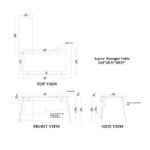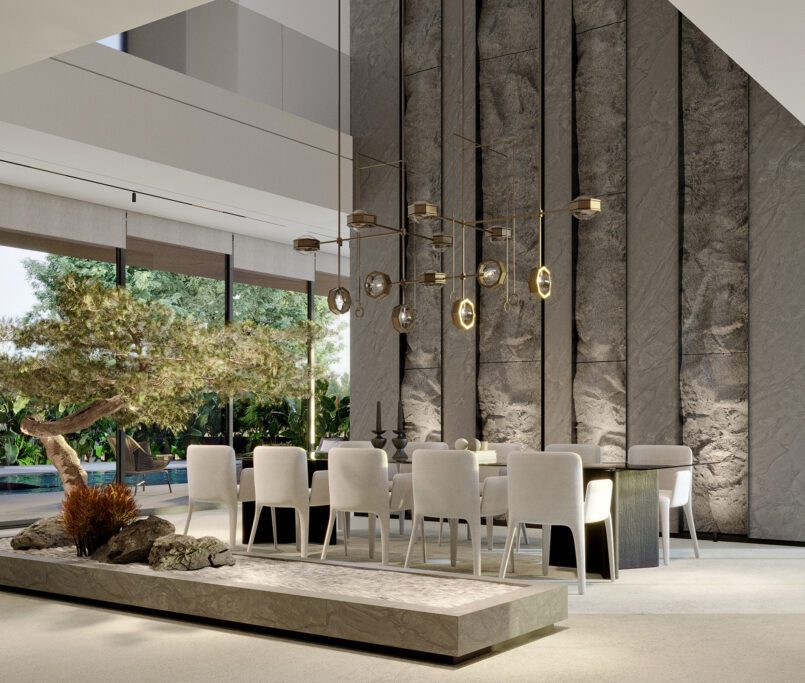I-Introduction
Interior design involves creating a balance between aesthetics, functionality, and space utilization. However, it can be challenging for designers and clients to visualize how the final design will appear in real life. That’s where 3D interior visualization services come in. With advancements in technology, designers can now create accurate, detailed, and visually stunning renderings of their designs. 3D visualization is becoming an essential tool in the interior design industry, transforming how designers work and communicate with clients.
In this article, we will explain the importance of 3D interior visualization services for interior design projects, discussing how they help designers improve design accuracy, communicate better with clients, and save time and money. We will also explore new technologies in 3D visualization and digital modeling and how they are shaping the future of interior design.
II-Improved Design Accuracy and Planning
A. Benefits of 3D Visualization in Space Planning
Ability to create accurate and detailed floor plans in 3D:
3D visualization allows designers to create detailed, accurate floor plans with precise measurements, which can help ensure that the final design will fit the space correctly.
3D floor plans can also provide a better understanding of spatial relationships and scale, which can be difficult to achieve with 2D floor plans.
Improved understanding of spatial relationships and scale:
3D visualization can help designers better understand how furniture and decor will fit and interact within a space.
This can help designers to optimize the layout of the space for functionality and flow, while also considering aesthetic preferences.
Ability to test different furniture and decor arrangements in real time:
3D visualization allows designers to quickly and easily test different furniture and decor arrangements in real-time, without the need for physical prototypes or mock-ups.
This can save time and money, while also allowing for greater flexibility and creativity in the design process.
B. Improved Accuracy and Precision in Design Decisions
Detailed and photorealistic renderings aid in decision-making:
3D visualization can provide highly detailed, photorealistic renderings of the proposed design, which can help clients and designers to make more informed decisions about materials, colors, textures, and finishes.
This can improve the accuracy and precision of design decisions, leading to a more satisfactory final design.
Clear visualization of material choices, colors, and textures:
3D visualization can provide clear and accurate visualizations of materials, colors, and textures, which can be difficult to convey through traditional design methods.
This can help designers and clients to make informed decisions about these important design elements.

Ability to identify potential design flaws before construction or installation:
3D visualization allows designers to identify potential design flaws and issues early in the design process, before construction or installation begins.
This can save time and money, as well as reduce the need for redesigns and revisions later on.
C. Identification and Prevention of Potential Issues Early in the Design Process
Ability to identify spatial issues and design flaws in the early stages:
3D visualization can help designers to identify potential spatial issues and design flaws early in the design process, before construction or installation begins.
This can help prevent costly and time-consuming mistakes later on.
Enhanced communication and collaboration among designers, clients, and contractors:
3D interior visualization services can enhance communication and collaboration among designers, clients, and contractors, by providing a clear and accurate visualization of the proposed design.
This can help ensure that all stakeholders are on the same page, and that the final design meets everyone’s expectations.
Time and cost savings from reducing the need for redesigns and revisions:
By identifying potential issues and flaws early in the design process, 3D visualization can help reduce the need for costly and time-consuming redesigns and revisions later on.
This can save both time and money, and help ensure that the final design is completed on schedule and within budget.
III. Better Client Communication
A-Advantages of 3D Visualization in Client Presentations
High-quality and engaging visualizations:
3D interior visualization services provides high-quality, engaging visualizations that can help clients to better understand and visualize the proposed design.
This can help clients to get excited about the project and feel more invested in the design process.
Interactive and immersive client experiences:
3D visualization can provide interactive and immersive client experiences, allowing clients to explore the proposed design in real-time and from multiple angles.
This can help clients to get a better sense of how the design will look and feel in real life.
Ability to customize designs in real-time:
3D visualization can allow clients to customize designs in real-time, by changing colors, textures, materials, and other design elements.
This can help clients to better understand their options and make more informed design decisions.
B. Improved Client Understanding of Design Concepts
Clear and accurate visualizations:
3D visualization provides clear and accurate visualizations of the proposed design, which can help clients to better understand and visualize the design concept.
This can help reduce confusion and misunderstandings, leading to a more satisfactory final design.
Enhanced communication and collaboration:
3D visualization can enhance communication and collaboration between designers and clients, by providing a clear and accurate visualization of the proposed design.
This can help ensure that all stakeholders are on the same page, and that the final design meets everyone’s expectations.
Improved ability to provide feedback:
3D visualization can help clients to provide more accurate and informed feedback on the proposed design, by allowing them to see and interact with the design in 3D.
This can help designers to make more informed design decisions, leading to a more satisfactory final design.
C. Increased Satisfaction and Trust in Design Projects
Increased client satisfaction:
3D visualization can help increase client satisfaction by providing a clear and accurate visualization of the proposed design, allowing clients to better understand and visualize the design concept.
This can lead to a more satisfactory final design, and a more positive client experience.
Increased trust and confidence in design projects:
3D visualization can help increase client trust and confidence in the design process, by providing a clear and accurate visualization of the proposed design and by allowing clients to provide more accurate and informed feedback.
This can help build stronger client-designer relationships, leading to more successful and profitable design projects in the future.
IV- Time-Saving and Cost-Effective
A. Reduction in Design Revisions and Project Delays
Early identification of design issues:
3D visualization can help identify design issues early in the design process, before construction begins.
This can help prevent costly and time-consuming design revisions and project delays later on.
Improved accuracy and precision in design decisions:
3D visualization provides designers with a clear and accurate visualization of the proposed design, allowing for more informed and precise design decisions.
This can help reduce the need for design revisions and project delays.
Streamlined communication and collaboration:
3D visualization can help streamline communication and collaboration between designers, clients, and other stakeholders, reducing the likelihood of misunderstandings and design errors.
B- Cost Savings in Materials and Labor
Reduced material waste:
3D visualization can help reduce material waste by allowing designers to experiment with different design elements and materials virtually, before construction begins.
This can help minimize the amount of materials that are wasted during the construction process.
Reduced labor costs:
3D visualization can help reduce labor costs by allowing designers to experiment with different design options virtually, before construction begins.
This can help minimize the amount of labor that is needed during the construction process, saving time and money.
Improved project cost estimates:
3D visualization can help improve project cost estimates by providing designers with a more accurate and detailed understanding of the proposed design.
This can help reduce the risk of cost overruns and unexpected expenses.
C-Enhanced Workflow and Project Management
Streamlined design process:
3D visualization can help streamline the design process by providing designers with a clear and accurate visualization of the proposed design.
This can help reduce the time and resources needed for design revisions and changes.
Improved project management:
3D visualization can help improve project management by providing designers with a clear and accurate visualization of the proposed design, allowing for more informed and effective decision-making.
This can help ensure that the project stays on track and on budget.
Improved workflow efficiency:
3D visualization can help improve workflow efficiency by allowing designers to experiment with different design options virtually, before construction begins.
This can help reduce the time and resources needed for design revisions and changes, and help ensure that the project is completed on time and on budget

V-Advanced Visualization Techniques
A. Emerging Technologies in 3D Visualization
1-Virtual Reality:
Virtual reality (VR) technology has the potential to revolutionize the way we visualize and experience architectural spaces.
VR can provide a fully immersive, interactive experience of a 3D design, allowing designers and clients to explore and interact with the space in real-time.
2-Augmented Reality:
Augmented reality (AR) technology can provide designers and clients with a real-time, interactive overlay of 3D designs onto the physical space.
This can help designers and clients visualize how the 3D design will look and feel in the real world.
3-3D Printing:
3D printing technology allows designers to create physical models of their 3D designs, allowing for a more tangible and detailed understanding of the proposed design.
B- Use of Photorealistic Renderings for Enhanced Visual Impact
HIGH-QUALITY VISUALIZATIONS:
Photorealistic renderings are 3D visualizations that are designed to look as realistic as possible.
They can help designers and clients visualize how the finished project will look, and can provide a more immersive and impactful experience.
Improved marketing and advertising:
Photorealistic renderings can also be used for marketing and advertising purposes, allowing designers and clients to showcase the project in the best possible light.
C-Industry Standards for 3D Visualization and Digital Modeling
Software and tools:
There are a variety of software and tools available for 3D visualization and digital modeling, including SketchUp, Revit, and 3Ds Max.
Designers and firms may have their own preferred software and tools, and may need to ensure that they meet industry standards and best practices.
Collaborative workflows:
Collaborative workflows are essential for effective 3D visualization and digital modeling.
This may involve working with a team of designers, clients, and other stakeholders to ensure that the project is on track and meets everyone’s needs and expectations.
V-Conclusion
In conclusion, the importance of 3D interior visualization services in interior design projects cannot be overstated. By utilizing these services, designers can improve the accuracy of their designs, save time and costs, and communicate better with clients.
Looking ahead, emerging technologies like virtual reality and augmented reality have the potential to revolutionize the industry. Designers should stay up-to-date with industry standards and best practices to ensure they are equipped to take advantage of these new technologies.
Overall, 3D interior visualization services are a game-changer for interior design projects, and designers who embrace these advanced visualization techniques will be best positioned for success in the future. By continuing to push the boundaries of what is possible, designers can create amazing spaces that meet their clients’ needs and exceed their expectations.






